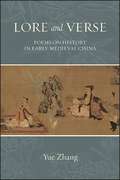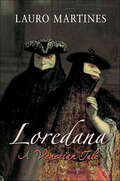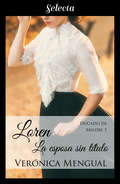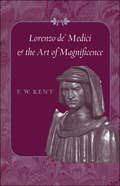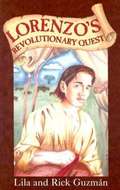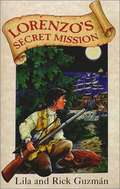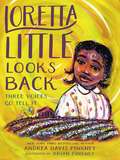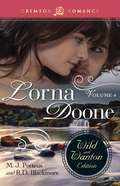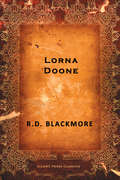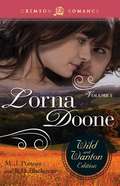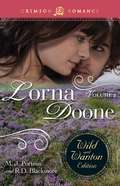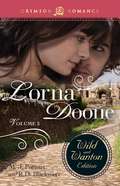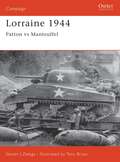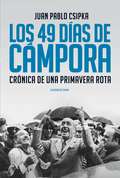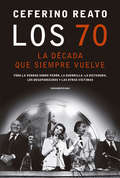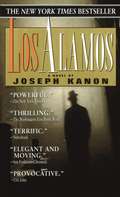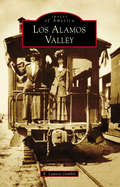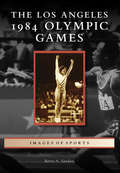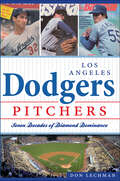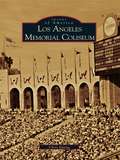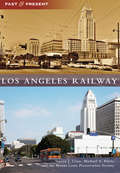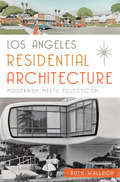- Table View
- List View
Lore and Verse: Poems on History in Early Medieval China (SUNY series in Chinese Philosophy and Culture)
by Yue ZhangLore and Verse is the first English-language book dedicated entirely to studying poems on history (yongshi shi) in premodern China. Focusing on works by poets from the entire range of early medieval China (220–589), Yue Zhang explores how history was disseminated and interpreted through poetry, as well as how and why certain historical figures were commemorated in poetry. In writing poems on history, poets retrospectively crafted their own identities through their celebration of historical figures, and they prospectively fortified a continuous lineage for transmitting their values and reputation to future generations. This continuous tradition of cultural memory informs a poet's reception of historical figures, which in turn shapes that tradition through further intertextual connections. Lore and Verse questions the sweeping generalization of early medieval Chinese poetry as consisting mainly of exuberant images and an ornamental style—an inaccurate characterization repeated by later historians and literary critics—and it provides translations, close readings, and analyses of selected poems on history that will be useful for students, instructors, and general readers interested in premodern Chinese literature and culture.
Loredana: A Venetian Tale
by Lauro MartinesA dark, riveting tale of love, politics, and religion in sixteenth-century Venice--the embodiment of Leonardo da Vinci's ideal city.In early sixteenth-century Italy, two lovers, Loredana and Orso, seem ready to die rather than be separated. Their tale unfolds in the two-tiered city of Venice, where the nobility have the upper tier and the light of the sun, while the common people, with their manual trades, occupy the lower city--the dark tier in the shadows. Violating social and religious taboos, the passion of the lovers bridges the two cities.A beautiful young widow, Loredana, dreads the cruel judgment of her family, one of the most powerful houses in republican Venice. Orso--a Dominican friar, mystic, and revolutionary--is in hiding, as the Venetian secret police scour the upper and lower cities for him. When the authorities close in, guardsmen control all streets and waterways, and the two lovers are driven to write out their penitential confessions, unable to reach the one priest who would not betray them.Conjuring up the voices of lovers and of their age through a rich array of letters, confessions, secret-police proceedings, a diary, and a family chronicle, this is an astonishing take of politics, love, lust, and religious incandescence.
Loren, la esposa sin título (Trilogía Ducado de Mildre #Volumen 1)
by Verónica Mengual¿Desafiarías las normas por amor? La hija de un importante duque debería casarse bien para honrar a su familia. Primera entrega de la trilogía «Ducado de Mildre». Lady Loren Lacrose nunca tomó la decisión de sacrificarse y entregarse en matrimonio al hombre que su padre ha elegido para ella, porque era un precio muy alto que parece no estar dispuesta a pagar. El señor Jenkins, ese lacayo que anda rompiendo toda la cristalería y la porcelana de la casa ha de ser suyo a toda costa, quiera él o no. Una dama no debería ir asediando así a un sirviente, pero la hija del duque está decidida a dejarlo todo por amor. ¿Estará dispuesto él a dejarse seducir por tan bella tentación?
Lorenz: Breaking Hitler’s Top Secret Code at Bletchley Park
by Jerry Roberts Paddy O'ConnellThe breaking of the Enigma machine is one of the most heroic stories of the Second World War and highlights the crucial work of the codebreakers of Bletchley Park, which prevented Britain’s certain defeat in 1941. But there was another German cipher machine, used by Hitler himself to convey messages to his top generals in the field. A machine more complex and secure than Enigma. A machine that could never be broken. For sixty years, no one knew about Lorenz or ‘Tunny’, or the determined group of men who finally broke the code and thus changed the course of the war. Many of them went to their deaths without anyone knowing of their achievements. Here, for the first time, senior codebreaker Captain Jerry Roberts tells the complete story of this extraordinary feat of intellect and of his struggle to get his wartime colleagues the recognition they deserve. The work carried out at Bletchley Park during the war to partially automate the process of breaking Lorenz, which had previously been done entirely by hand, was groundbreaking and is recognised as having kick-started the modern computer age.
Lorenzo de' Medici and the Art of Magnificence (The Johns Hopkins Symposia in Comparative History #24)
by F. W. KentIn the past half century scholars have downplayed the significance of Lorenzo de' Medici (1449–1492), called "the Magnificent," as a patron of the arts. Less wealthy than his grandfather Cosimo, the argument goes, Lorenzo was far more interested in collecting ancient objects of art than in commissioning contemporary art or architecture. His earlier reputation as a patron was said to be largely a construct of humanist exaggeration and partisan deference.Although some recent studies have taken issue with this view, no synthesis of Lorenzo as art patron and art lover has yet emerged. In Lorenzo de' Medici and the Art of Magnificence historian F. W. Kent offers a new look at Lorenzo's relationship to the arts, aesthetics, collecting, and building—especially in the context of his role as the political boss (maestro della bottega) of republican Florence and a leading player in Renaissance Italian diplomacy. As a result of this approach, which pays careful attention to the events of his short but dramatic life, a radically new chronology of Lorenzo's activities as an art patron emerges, revealing them to have been more extensive and creative than previously thought. Kent's Lorenzo was broadly interested in the arts and supported efforts to beautify Florence and the many Medici lands and palaces. His expertise was well regarded by guildsmen and artists, who often turned to him for advice as well as for patronage. Lorenzo himself was educated in the arts by such men, and Kent explores his aesthetic education and taste, taking into account what is known of Lorenzo's patronage of music and manuscripts, and of his own creative work as a major Quattrocento poet. Richly illustrated with photographs of Medici landmarks by Ralph Lieberman, Lorenzo de' Medici and the Art of Magnificence offers a masterful portrait of Lorenzo as a man whose achievements might have rivaled his grandfather's had he not died so young.
Lorenzo di Filippo Strozzi and Niccolo Machiavelli
by William J. LandonBy 1520, Niccolò Machiavelli's life in Florence was steadily improving: he had achieved a degree of literary fame, and, following his removal from the Florentine Chancery by the Medici family, he had managed to gain their respect and patronage. But there is one figure whose substantial contributions to Machiavelli's restoration has been hitherto neglected - Lorenzo di Filippo Strozzi (1482-1549), a younger and fabulously wealthy Florentine nobleman. As manuscript evidence suggests, Strozzi brought Machiavelli into his patronage network and aided many of his post-1520 achievements.This book is the first English biography of Strozzi, as well as the first examination of the patron-client relationship that developed between the two men. William J. Landon reveals Strozzi's influence on Machiavelli through wide-ranging textual investigations, and especially through Strozzi's Pistola fatta per la peste - a work that survives as a Machiavelli autograph, and for which Landon has provided the first ever complete English translation and critical edition.
Lorenzo's Revolutionary Quest
by Rick Guzman Lila GuzmanIn 1777, under orders from George Washington, sixteen-year-old Captain Lorenzo Bannister drives 500 head of cattle east from San Antonio, Texas, to feed the Continental Army while enemies, old and new, plot against him.
Lorenzo's Secret Mission
by Rick Guzman Lila GuzmanIn 1776, fifteen-year-old Lorenzo Bannister leaves Texas and his father's new grave to carry a letter to the Virginia grandfather he has never known, and becomes involved with the struggle of the American Continental Army and its Spanish supporters.
Loretta Little Looks Back: Three Voices Go Tell It
by Andrea Davis PinkneyFrom a bestselling and award-winning husband and wife team comes an innovative, beautifully illustrated novel that delivers a front-row seat to the groundbreaking moments in history that led to African Americans earning the right to vote."Right here, I'm sharing the honest-to-goodness." -- Loretta"I'm gon' reach back, and tell how it all went. I'm gon' speak on it. My way." -- Roly"I got more nerve than a bad tooth. But there's nothing bad about being bold." -- Aggie B.Loretta, Roly, and Aggie B., members of the Little family, each present the vivid story of their young lives, spanning three generations. Their separate stories -- beginning in a cotton field in 1927 and ending at the presidential election of 1968 -- come together to create one unforgettable journey. Through an evocative mix of fictional first-person narratives, spoken-word poems, folk myths, gospel rhythms and blues influences, Loretta Little Looks Back weaves an immersive tapestry that illuminates the dignity of sharecroppers in the rural South. Inspired by storytelling's oral tradition, stirring vignettes are presented in a series of theatrical monologues that paint a gripping, multidimensional portrait of America's struggle for civil rights as seen through the eyes of the children who lived it. The novel's unique format invites us to walk in their shoes. Each encounters an unexpected mystical gift, passed down from one family member to the next, that ignites their experience what it means to reach for freedom.
Lorna Doone
by R. D. Blackmore M. J. PorteusOn the border of the English counties of Devon and Somerset, John Ridd's father is a yeoman farmer murdered in cold blood by a member of the notorious Doone family. John is besotted with Lorna, the granddaughter of the head of the Doone clan, who is to be forced to marry the evil Carver Doone. John helps Lorna escape, but circumstances lead to the discovery that she is not a Doone after all, and the newfound heiress moves. But the Monmouth Rebellion finds John wrongly accused of treason and he has to clear his name in London, where he finds Lorna once more and where their love is rekindled. He is granted a royal pardon, and later Lorna is allowed to join him at his Exmoor farm. Just as they are married in Oare church, Carver Doone shoots Lorna at the altar and John, believing her dead, pursues and kills him. But is his love really dead?Although Lorna Doone is perceived as a romance, it is set in the 1600s, when writings about sexual life at the court and personal diaries such as those of Pepys could be incredibly graphic, even by today's standards. They were especially scandalous in the prudish Victorian times of the author. Had Blackmore written it in the seventeenth century, or in modern times, he probably would have done so similarly to this updated version and built on the existing innuendo.Sensuality Level: Spicy
Lorna Doone: A Romance Of Exmoor, Volume 1
by R. L. BlackmoreJohn Ridd has worked hard to build a respectable life as a farmer when he falls in love with Lorna Doone, a member of the clan responsible for the death of his father. Desperate to save his love from Carver, to whom she's betrothed, John helps Lorna escape, only to uncover the truth about her parentage, which changes everything for them both.
Lorna Doone: The Wild And Wanton Edition Volume 1
by M. J. PorteusOn the border of the English counties of Devon and Somerset, John Ridd’s father is a yeoman farmer murdered in cold blood by a member of the notorious Doone family. John is besotted with Lorna, the granddaughter of the head of the Doone clan, who is to be forced to marry the evil Carver Doone. John helps Lorna escape, but circumstances lead to the discovery that she is not a Doone after all, and the newfound heiress moves. But the Monmouth Rebellion finds John wrongly accused of treason and he has to clear his name in London, where he finds Lorna once more and where their love is rekindled. He is granted a royal pardon, and later Lorna is allowed to join him at his Exmoor farm. Just as they are married in Oare church, Carver Doone shoots Lorna at the altar and John, believing her dead, pursues and kills him. But is his love really dead?Although Lorna Doone is perceived as a romance, it is set in the 1600s, when writings about sexual life at the court and personal diaries such as those of Pepys could be incredibly graphic, even by today’s standards. They were especially scandalous in the prudish Victorian times of the author. Had Blackmore written it in the seventeenth century, or in modern times, he probably would have done so similarly to this updated version and built on the existing innuendo.Sensuality Level: Spicy
Lorna Doone: The Wild And Wanton Edition Volume 2
by M. J. PorteusOn the border of the English counties of Devon and Somerset, John Ridd’s father is a yeoman farmer murdered in cold blood by a member of the notorious Doone family. John is besotted with Lorna, the granddaughter of the head of the Doone clan, who is to be forced to marry the evil Carver Doone. John helps Lorna escape, but circumstances lead to the discovery that she is not a Doone after all, and the newfound heiress moves. But the Monmouth Rebellion finds John wrongly accused of treason and he has to clear his name in London, where he finds Lorna once more and where their love is rekindled. He is granted a royal pardon, and later Lorna is allowed to join him at his Exmoor farm. Just as they are married in Oare church, Carver Doone shoots Lorna at the altar and John, believing her dead, pursues and kills him. But is his love really dead?Although Lorna Doone is perceived as a romance, it is set in the 1600s, when writings about sexual life at the court and personal diaries such as those of Pepys could be incredibly graphic, even by today’s standards. They were especially scandalous in the prudish Victorian times of the author. Had Blackmore written it in the seventeenth century, or in modern times, he probably would have done so similarly to this updated version and built on the existing innuendo.Sensuality Level: Spicy
Lorna Doone: The Wild And Wanton Edition Volume 3
by M. J. PorteusOn the border of the English counties of Devon and Somerset, John Ridd’s father is a yeoman farmer murdered in cold blood by a member of the notorious Doone family. John is besotted with Lorna, the granddaughter of the head of the Doone clan, who is to be forced to marry the evil Carver Doone. John helps Lorna escape, but circumstances lead to the discovery that she is not a Doone after all, and the newfound heiress moves. But the Monmouth Rebellion finds John wrongly accused of treason and he has to clear his name in London, where he finds Lorna once more and where their love is rekindled. He is granted a royal pardon, and later Lorna is allowed to join him at his Exmoor farm. Just as they are married in Oare church, Carver Doone shoots Lorna at the altar and John, believing her dead, pursues and kills him. But is his love really dead?Although Lorna Doone is perceived as a romance, it is set in the 1600s, when writings about sexual life at the court and personal diaries such as those of Pepys could be incredibly graphic, even by today’s standards. They were especially scandalous in the prudish Victorian times of the author. Had Blackmore written it in the seventeenth century, or in modern times, he probably would have done so similarly to this updated version and built on the existing innuendo.Sensuality Level: Spicy
Lorna Doone: The Wild And Wanton Edition Volume 4
by M. J. PorteusOn the border of the English counties of Devon and Somerset, John Ridd’s father is a yeoman farmer murdered in cold blood by a member of the notorious Doone family. John is besotted with Lorna, the granddaughter of the head of the Doone clan, who is to be forced to marry the evil Carver Doone. John helps Lorna escape, but circumstances lead to the discovery that she is not a Doone after all, and the newfound heiress moves. But the Monmouth Rebellion finds John wrongly accused of treason and he has to clear his name in London, where he finds Lorna once more and where their love is rekindled. He is granted a royal pardon, and later Lorna is allowed to join him at his Exmoor farm. Just as they are married in Oare church, Carver Doone shoots Lorna at the altar and John, believing her dead, pursues and kills him. But is his love really dead?Although Lorna Doone is perceived as a romance, it is set in the 1600s, when writings about sexual life at the court and personal diaries such as those of Pepys could be incredibly graphic, even by today’s standards. They were especially scandalous in the prudish Victorian times of the author. Had Blackmore written it in the seventeenth century, or in modern times, he probably would have done so similarly to this updated version and built on the existing innuendo.Sensuality Level: Spicy
Lorraine 1944
by Steven Zaloga Tony BryanOsprey's examination of the confrontation between the US Army and German forces in Lorraine during World War II (1939-1945). In the wake of the defeat in Normandy in the summer of 1944, Hitler planned to stymie the Allied advance by cutting off Patton's Third Army in the Lorraine with a great Panzer offensive. But Patton's aggressive tactics continued to thwart German plans and led to a series of violent armored battles. The battle-hardened Wehrmacht confronted the better-equipped and better-trained US Army. The Germans managed to re-establish a fragile defensive line but could not stop the US Army from establishing bridgeheads over the Moselle along Germany's western frontier.
Los 49 días de Cámpora: Crónica de una primavera rota
by Juan Pablo CsipkaCrónica periodística sobre la presidencia de Héctor Cámpora en 1973, díapor día. La presidencia de Héctor Cámpora, un período de efervescencia ymovilización, significó el fin de 18 años de proscripción del peronismo.El gobierno de 49 días fue la antesala para la candidatura presidencialde Juan Domingo Perón, inhabilitado por los militares para presentarse alos comicios a los que finalmente concurrió Cámpora en su nombre.Reivindicado por el kirchnerismo y la generación del 73, el presidentede siete semanas intensas fue el nexo entre el fin de la RevoluciónArgentina y la tercera presidencia de Perón, en un momento defragmentación en el seno del movimiento justicialista. Este trabajorecrea el día a día del gobierno vicario, desde el 25 de mayo hasta el13 de julio de 1973, deteniéndose en los momentos más significativos deesas semanas históricas: la liberación de los presos de Devoto, laamnistía, el programa económico de Gelbard, el ascenso a la primeraescena de López Rega, el viaje de Cámpora a Madrid, la masacre deEzeiza, el final del gobierno camporista. Es también un recorrido por lamúsica, la literatura, el cine, las costumbres, el sentir cotidiano dela sociedad argentina en aquel clima, en un intento por recrear laatmósfera de esas semanas, en un año clave de la historia argentina.
Los 70, la década que siempre vuelve: Toda la verdad sobre Perón, la guerrilla, la dictadura, los desaparecidos y las otras víctimas
by Ceferino ReatoLa historia definitiva sobre los 70: la década en la que la Argentina llegó a naturalizar la violencia política y vivió horrores que aún estremecen. Toda la verdad sobre Perón, la guerrilla, la dictadura, los desaparecidos y las otras víctimas desde un punto de vista objetivo que presenta los hechos y se abstiene de interpretaciones simplistas. Pronto habrá pasado medio siglo y los argentinos seguiremos discutiendo una y otra vez sobre los 70. En efecto, los 70 siguen vivos, siempre vuelven. O nunca terminan de pasar. Esos años, verdadera orgía de sueños, ideales, sangre y muerte, vieron desfilar tres "patrias" por una misma nación: la socialista, que nunca llegó a nacer; la peronista, que se hizo añicos en poco tiempo; y la militar, cuyos horrores aún estremecen. No hay tragedia griega que se haya atrevido a tanto y, tal vez por eso, esa década -en la que la violencia política da la impresión de haber sido naturalizada- nos sigue interesando y atrayendo. Sin embargo, buena parte de lo dicho y escrito sobre ella lleva impresa la marca de la simplificación maniquea que presenta al pasado como una sucesión de episodios en el que batallan buenos y malos. En búsqueda de consuelo o justificación, unos y otros construyen su relato y, de ese modo, le hacen flaco favor a la historia. Y a la sociedad, porque ¿puede alguien arrogarse el monopolio del sufrimiento? Este libro sostiene que no. En él, Ceferino Reato renuncia a la interpretación y brinda a sus lectores los elementos para que hagan la propia. Logra así lo que parecía una empresa imposible: reunir todo el conocimiento objetivo sobre los 70 del que disponemos los argentinos hasta la fecha en una obra única, que conjuga la información rigurosa que hace justo su contenido con el pulso narrativo que hace apasionante su lectura.
Los Alamos
by Joseph KanonIn a dusty, remote community of secretly constructed buildings and awesome possibility, the world's most brilliant minds have come together. Their mission: to split an atom and end a war. But among those who have come to Robert Oppenheimer's enchanted campus of foreign born scientists, baffled guards, and restless wives is a simple man, an unravel er of human secrets, a man in search of a killer. It is the Spring of 1945, and Michael Connelly has been sent to Los Alamos to investigate the murder of a security officer on the Manhattan Project. But amid the glimmering cocktail parties and the staggering genius, Connelly will find more than he is bargained for. Sleeping in a dead man's bed and making love to another man's wife, this place of discovery and secrecy, hope and horror, Connelly is plunged into a shadowy war with a killer, as the world is about to be changed forever.
Los Alamos Valley
by R. Lawson GambleLos Alamos is a small town on its way to big things. It is a growing tourist destination yet retains its pastoral charm. The history of the Los Alamos Valley can be viewed as a microcosm of the history of California, for it contains within its span Chumash Indians, mission neophytes and horse herds, Spanish land grants, cattle ranches, vaqueros, bandits, oil bonanzas, a narrow-gauge railroad, fertile soil for bountiful crops, vast vineyards, tourism, and even an element of Hollywood. Its location on the Central Coast of California means sunny skies, cool evenings, and cool, damp breezes. The character and resilience of the Los Alamos Valley inhabitants, however, is the real story. Theirs is a history of intermingling cultures and races, a steadfast preservation of traditions, and a pioneer streak of stubborn perseverance in the face of natural and economic adversity. The images in this book were gathered as the result of a community effort.
Los Angeles 1984 Olympic Games, The (Images of Sports)
by Barry A. SandersThe Games of the XXIII Olympiad, Los Angeles 1984, reimagined the Olympic Games and reinvigorated a troubled Olympic movement. Its innovations included the following: a nationwide torch relay that yielded millions for children's charities; an arts festival that surpassed any prior efforts; the first Opening Ceremony featuring a professional theatrical extravaganza; new sports disciplines, such as distance races for women, windsurfing, synchronized swimming, heptathlon, and rhythmic gymnastics; an army of volunteers; vast increases in sponsorship and television revenue while avoiding commercialization and keeping expenses low using existing facilities; and a financial surplus of over $232 million, which has endowed sports for youngsters in the Los Angeles area to this day--all through a privately financed organizing committee without government contributions.
Los Angeles Dodgers Pitchers: Seven Decades of Diamond Dominance (Sports)
by Don LechmanThe Los Angeles Dodgers have always fielded one of the best pitching staffs in the Major Leagues. With Don Drysdale and Sandy Koufax, Fernando Valenzuela and Orel Hershiser and closers Mike Marshall and Eric Gagne, it's hard to imagine a more sterling roster. After their 1958 arrival from Brooklyn, the Dodgers won five World Series, competed in nine and made the playoffs in eleven other seasons--by leaning on their pitchers. The Dodgers have nine Cy Young Awards, more than any other franchise. In their fifty-three years in LA, the Dodgers have led the National League in team earned run average a staggering twenty times. Join author Don Lechman, a Los Angeles newspaperman for forty years, as he recounts the history of the team's aces.
Los Angeles Memorial Coliseum
by Chris EptingOpened to the public in June of 1923, the Los Angeles Memorial Coliseum can arguably be called "America's Most Historic Sports Stadium." In 1984 the Memorial Coliseum was declared a State and Federal Historic Landmark for its contributions to both the State of California and the United States. The history of this institution is captured here in over 200 vintage images.The Memorial Coliseum's history spans eight decades, playing host to two Olympiads, two Super Bowls, one World Series, a multitude of concerts and political rallies, a Papal mass, and one of the most famous Democratic presidential nomination acceptance speeches of the 20th century by John F. Kennedy. Using photographs culled from its archives, pictured here are never-before-seen photographs of the Coliseum's construction; rare images of political and religious rallies held at the Stadium and the Los Angeles Sports Arena, and home to famous speeches by Franklin Roosevelt, Martin Luther King Jr., and Nelson Mandela; and a myriad of other sporting and entertainment events hosted by the Memorial Coliseum, including the Los Angeles Dodgers, motocross racing, and the Rolling Stones.
Los Angeles Railway (Past and Present)
by Steven J. Crise Michael A. Patris the Mount Lowe Preservation SocietyThe Los Angeles Railway's Yellow Cars, a system cobbled together from numerous horse-powered lines, cable car lines, and upstart narrow-gauge trolley companies, served downtown and its environs in some iteration from 1898 to 1963. Henry Huntington assembled this conglomerate, making it functionally effective and well patronized.
Los Angeles Residential Architecture: Modernism Meets Eclecticism
by Ruth WallachDuring the first half of the twentieth century, Los Angeles grew into a sprawling metropolis. As suburbs developed, demonstration homes and housing exhibitions brought innovative architectural and interior design styles. Displays like the California Home and Garden Exhibition showcased the latest in timesaving appliances, modern furniture and cutting-edge building techniques meant to represent the future and ideals of Southern California living. Model and tract home exhibitions like those at Leimert Park inspired a new generation of homebuyers. Designed to house the masses, multi-family developments like the Zigzag Moderne-style Val d'Amour were benchmarks for their time. Join author Ruth Wallach on a tour of the varied Modernist styles that give Los Angeles its distinct residential landscape.
